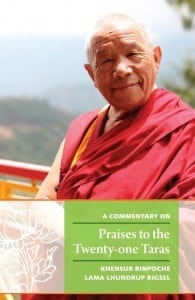
Praises to the Twenty-one Taras. Tara is a deity whom all the sects of Tibetan Buddhism has relied upon. Also the ancient Indian masters of the past, such as Atisha, relied on Tara as a special deity. The great Kadampa masters of Tibet, Lama Tsongkhapa and all the lineage gurus relied on Tara. In short, when you look at all the holy beings of the four different traditions—Nyingma, Sakya, Kagyü and Gelug—they had relied on Tara as their special deity. They all received blessings and attainments just by doing the practice of the female Bodhisattva Tara. This book is a guide on how to use and understand the twenty-one verses of the Praises to the Twenty-one Taras.
Download the free e-book here:
 Praises to the Twenty-one Taras
Praises to the Twenty-one Taras
About the deity Tara
Tara is a goddess in Hindu and Buddhist mythology who is associated with compassion, protection, and spiritual fulfillment. In Hinduism, she is considered to be an aspect of the goddess Parvati, the wife of Shiva. In Buddhism, Tara is seen as a female bodhisattva, or enlightened being, who is devoted to helping others attain enlightenment.
Tara is often depicted in art and literature as a beautiful woman with a serene and gentle expression on her face. She is usually shown holding a lotus flower, which symbolizes purity and spiritual enlightenment. In Buddhist teachings, Tara is said to have many different forms, each with its own specific qualities and abilities. For example, the Green Tara is associated with courage and protection, while the White Tara is associated with healing and longevity.
Buddhists often pray to Tara for protection and guidance, and she is particularly revered by women. In Tibetan Buddhism, Tara is considered to be a “motherly” figure who is devoted to the well-being of her devotees. Many people also turn to Tara for help in overcoming difficulties and challenges in their lives.

